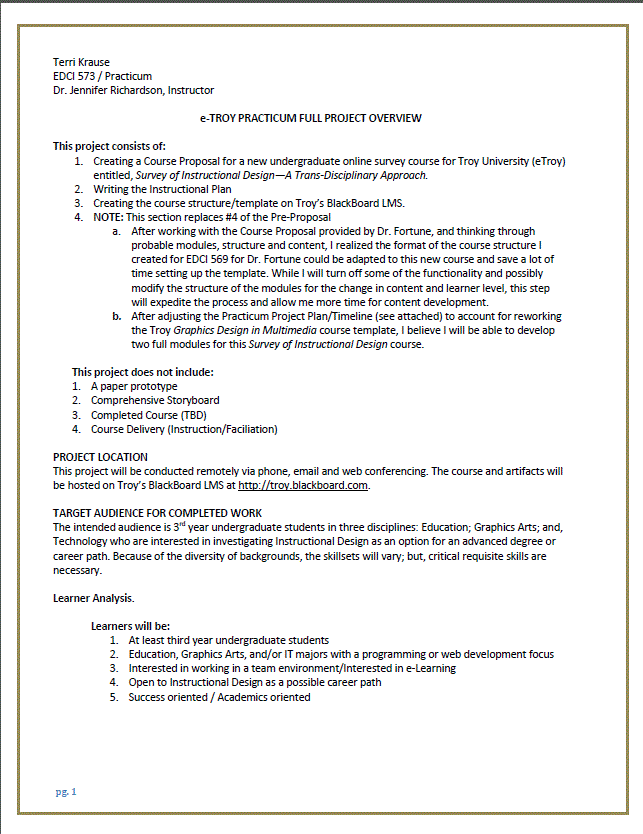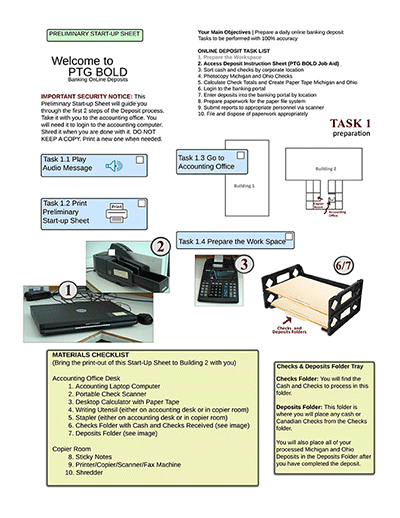Apply Instructional Design Principles

Sub-Competency 1: Design, plans, and develops instructional interventions using appropriate strategies and techniques
As evidence of my ability to identify and analyze a learning and performance problem, I offer my Full Proposal for EDCI 573 in which I present a performance gap that became apparent to me early in my MSEd program. Working with my classmates, I realized that many had little exposure to the technologies used in Instructional Design, and few have other than peripheral experience with graphics design. I have helped many of my classmates with tech and design issues; but, felt there was a real need for students in the respective disciplines to learn about instructional design earlier in their career paths and also to be better prepared if they find themselves members of an ID team and/or decide to pursue a graduate degree in the field. My Full Proposal, which was accepted by Dr. Fortune, Director of Troy University’s e-Learning program includes the following Learner Objectives:
The integrated approach would allow students to understand the role of each of the main players involved in Instructional Design; provide a working vocabulary comprised of language specific to each domain as well as to the field of Instructional Design as a whole; provide a basic understanding of the theory, models, modes, methods, and means of instructional delivery; provide an opportunity to collaborate on small instructional projects; and provide an opportunity to share ideas about best practices and the future of instruction based on trends in education, design, and technology with practical demonstration of the integration of the system(s). The make-up of the class will ensure an inherent scaffolding structure to off-set the gaps in background training and/or experience (Krause, 2015, p. 3).
During the course of this program, I have found the principles becoming easier to comprehend, remember and employ as we read, analyzed and created interventions and assessments. Some have even achieved a level of automaticity (Driscoll, 2005, pp. 80-82). As I gathered the artifacts for this narrative, I was struck by some errors in execution that now jump out at me. While it is somewhat embarrassing, it also shows growth; and I have to remind myself that this is what education is all about. If I saw no change, that would be cause for alarm. I intend and expect that I will continue to grow in my ability to analyze performance problems, design instructional interventions and design and implement sound evaluations that both address the needs of the learners and the refinement of the instruction. I also expect that my understanding of the various Learner Groups will grow with experience, and I will begin to know intuitively what interventions will and will not be applicable.

Sub-Competency 2: Design, plans, and develops instructional interventions using appropriate strategies and techniques
PGT is a Michigan manufacturing company with a unique performance gap. Only two employees can make deposits and if by chance both should be out of the office, the task cannot be performed. The artifact I offer to demonstrate Sub-Competency 2 is a Deposits Process Jobaid I created for PGT. The delivery vehicle is Adobe Acrobat and was chosen because of the need for greater security of process and passwords. The Jobaid was created in two parts. The Start File resides in a hidden folder on the network that can only be accessed by pre-authorized personnel when alerted by email; and the PTG Deposit Process is on the Accounting computer which has no access to the network or hidden folder. Other functionality is built into the Jobaid to further enhance security and/or to aid in performance of the deposit process. Some information is provided both in text and audio or video form to facilitate use. The Jobaid was structured for two learning scenarios: 1) The user is a substitute who needs to perform the function once or for a short period of time, but, with 100% accuracy; or, 2) The user is a new employee who is being trained to perform the process as part of his/her job description. A training process is included for Scenario 2 and an evaluation methodology for both scenarios is included as part of the deliverable to the client. This JobAid represents an analysis of the performance gap, a plan for bridging the gap, and a design and implementation of a suitable solution that utilizes appropriate strategies and techniques.
Sub-Competency 3: Develops an evaluation plan for a project based on stated goals and recognized standards
Sub-Competency 3 deals with the evaluation of a project, and I offer my Evaluation Plan written for EDCI 577 as evidence of my understanding and execution of this competency. This plan was designed and implemented for a course I created for my high school students prior to their entrance into college. The performance gap I had observed involved a lack of understanding and use of the Course Management System (CMS) by my first year college students. Some had failed their classes and had never logged into to Moodle or Blackboard, etc. One had done all of his assignments but did not know he was supposed to upload them via the CMS and had for that reason failed the class, despite having all A’s on his tests and quizzes. My students are first generation and too timid to ask for help or to tell anyone they did not know what to do. I designed thegoodlife101.com as an intro to a CMS, so that my students could learn how to navigate an online learning system prior to entering college. In creating the course, I built in several levels of evaluation. This artifact details the evaluation methodologies and tools I used.
Because learning is evidenced in the “persisting change in performance or performance potential…” (Driscoll, 2005, p. 1), this 7th Competency—The Application of Instructional Design Principles—indicates the possibility that learning has occurred. Although Kirkpatrick argues, and rightfully so, that behavioral changes (Level 2) only prove the learning activities can be performed at the time of training, the persistence in applying the principles and methodologies indicates true Level 3 learning has occurred (Kirkpatrick, 2006).
Citations
Krause, T. (2015). Full proposal for Troy University. EDCI 573. Purdue University.